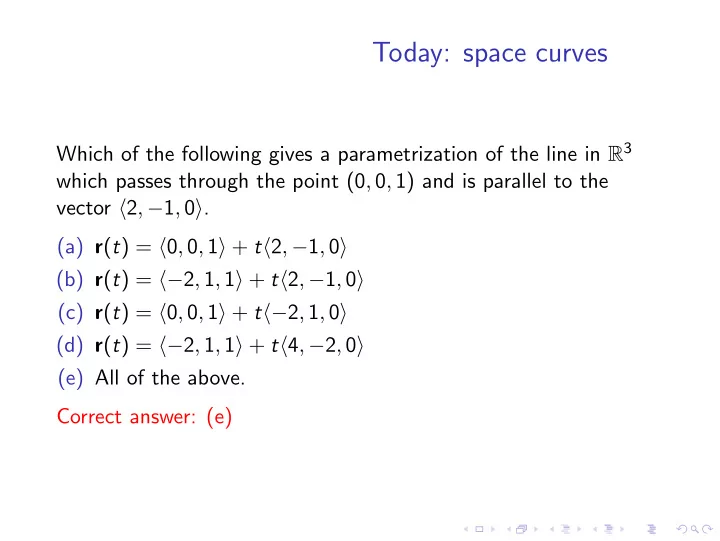

Today: space curves Which of the following gives a parametrization of the line in R 3 which passes through the point (0 , 0 , 1) and is parallel to the vector ⟨ 2 , − 1 , 0 ⟩ . (a) r ( t ) = ⟨ 0 , 0 , 1 ⟩ + t ⟨ 2 , − 1 , 0 ⟩ (b) r ( t ) = ⟨− 2 , 1 , 1 ⟩ + t ⟨ 2 , − 1 , 0 ⟩ (c) r ( t ) = ⟨ 0 , 0 , 1 ⟩ + t ⟨− 2 , 1 , 0 ⟩ (d) r ( t ) = ⟨− 2 , 1 , 1 ⟩ + t ⟨ 4 , − 2 , 0 ⟩ (e) All of the above. Correct answer: (e)
Things we’re not covering: 1 curvature 2 normal vectors, binormal vectors 3 tangent and normal components of acceleration
A helix
Practice with space curve parametrizations Consider the following curve. Which of the equations could be a parametrization? (a) r ( t ) = ⟨ cos t , sin t , t ⟩ . (b) r ( t ) = ⟨ cos t , t , sin t ⟩ . (c) r ( t ) = ⟨ cos t , sin t , 1 t ⟩ . (d) r ( t ) = ⟨ cos t , sin t , t 2 ⟩ . (e) None of these. Correct answer: (d)
Finding arc-length √ Consider the curve parametrized by r ( t ) = ⟨ t , 1 − t 2 ⟩ , − 1 ≤ t ≤ 1. What is its length? Hint: Sketch a picture. (a) I can’t remember how to calculate the integral. (b) π √ (c) 2 2 (d) 2 π √ (e) 2 Correct answer: (b)
Recommend
More recommend